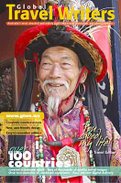The
island in Garci Rodriguez de Montalvo’s description was ruled by
Califia, a magnificent negress by all accounts. Her domain, like the
Amazons, was a matriarchal dominion where the few men were subjugated
and enslaved.
When it suited her, Califia
would muster her troops and raid neighbouring lands, seizing men and
territory. Her warriors wore gold armour and rode fierce steeds.
Some
researchers are convinced a fearsome black queen of either African or
Polynesian origin once existed on these shores, and de Montalvo, like
Shakespeare, had adapted legend and lore for his own purposes.
The
Spanish novelist, a contemporary of Christopher Columbus, whose lurid
prose described these lands in great detail, was sufficiently convincing
for the Mexican Governor, Hernan Cortes, to send ships in search of
this land of plenty. Like so many Spanish follies of the time, they
ended in disaster for the explorers and all those they encountered. The
island of California, however, persisted on maps for more than 100 years
and wasn’t conclusively disproved by land explorers until almost the
19th century.
Today this giant spurlike
peninsula, the second largest in the world, is part of Mexico and called
Baja California. It is divided into two ‘free and sovereign states’;
Baja California and Baja California Sur (south). The Gulf of California
enclosed by the peninsula is also known by its alternative moniker, The
Sea of Cortes (or Cortez).
At the very tip
is the resort town of Cabo San Lucas (Cape Saint Luke), which has grown
progressively from a grubby mining village and tuna cannery to one of
Mexico’s premier tourist locations and aquatic playgrounds.
Much
of the credit for this popular acceleration is due to the Nobel and
Pulitzer Prizewinning author, John Steinbeck, whose account of a marine
biology expedition in 1940 with his biologist friend, Ed Ricketts,
spawned the 288page nonfiction book The Log From The Sea Of Cortez,
published in 1950. Steinbeck describes this lost world as “ferocious
with life”, often citing his fear of man’s potential for destruction
through urban development and careless fishing techniques. Even as the
pair travelled, a hotel was being built along with the
airport
and railway. And develop it did. Cabo San Lucas quickly became the
playground for Hollywood A-listers and celebrities like John Wayne,
Chuck Connors, Desi Arnaz, Lucille Ball, Bing Crosby, Jacques Cousteau
and Ernest Hemingway.
Cousteau, who
visited some 35 years ago coined the tagline “the world’s aquarium”,
often re-used by the new wave of adventure cruise operators probing much
further north than any of the floating behemoths visiting Cabo San
Lucas.
The undisputed leader in this field
is Lindblad Expeditions, who have been exploring the Sea of Cortez
since Cousteau’s time. In 1977, a young Sven Lindblad was travelling
from Argentina to Mexico on his late father’s ship, the MS Lindblad
Expolorer. They had a few days to spare and decided to call in to the
Gulf of California to explore.
“I was
particularly attracted to this large island just up from the southern
end in the Gulf of California,” Lindblad recalls. “I’ve never seen
anywhere so beautiful, so irresistible.”
Lindblad
began commercial voyages in 1981 and UNESCO bestowed World Heritage
status on the region, stating the “diversity of terrestrial and marine
life is extraordinary and constitutes a unique eco region of high
priority for biodiversity conservation”.
Today
two of the company’s 62-passenger vessels operate side-by-side on
itineraries of either one or two weeks’ duration, plunging guests into
an experience that includes observation and encounters with all manner
of whales, sea lions, marine birds and land reptiles.
I’m
aboard an itinerary that probes deep into the gulf as far as Isla San
Esteban. For a full week, we explore the inside leg of the Gulf of
California, going ashore for nature hikes, early morning yoga, town
visits, snorkelling in the coves, photography classes as well as
kayaking along the craggy shores.
Our
expedition team of naturalists are unrelenting in their enthusiasm and
desire to share and impart their vast knowledge and in this respect, I
place the Lindblad Expeditions-National Geographic crew consistently
among the very best in this arena.
Our
ship, the National Geographic Sea Lion, is cosy, comfortable and
unpretentious. While it’s ideal for the destination, cruise snobs would
remark on the compact cabins and lack of lavish accoutrements. But none
of my fellow travellers lament the lack of big ship, mass market
niceties.
I’m certain even the feared Queen Califia herself would welcome us into her domain.


